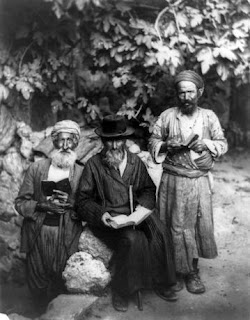The Turban: The Early Jewish Head Covering
Thursday, October 15, 2015
 |
| Jews wearing turbans in Jerusalem 1895 |
It is not unusual for someone to question the reason for wearing the beanie (kippah/yarmulke) commonly sported by traditional Jews. Common answers include the explanations that a head covering is a constant reminder that Jews are under submission to the Creator (Talmud Bavli, Kiddushin 32a), as an identifying symbol that Jews are set-apart from the other nations and that it is descended from middle/near eastern cultural norm wherein one can find traditions that view the uncovered head as a symbol of brazenness and disrespect. Since ancient times the head covering of men was used to distinguish between cultural groups and nationalities. Besides ethnicity, the head covering also served as indicators or wealth, status, position, and lineage. Women also wore a covering on their head and customs varies throughout history, from the earliest simple head bands of the ancient Israelite women to the full head and lower face coverings in second-temple Judea to the scarfs and wigs worn by the modern Jewess. Head coverings for both men and women have been a historical expression of Jewish identity for millennia.
In Biblical times the Levites and the High Priest would wear a head covering as part of the priestly vestments. The Scriptural record is replete with references to the turban of the Priest:
"These are the garments they are to make: a breast piece, an ephod, a robe, a woven tunic, a turban and a sash." (Ex. 28:4)
"Put the turban on his head and attach the sacred emblem to the turban." (Ex. 29:6)
"He also placed the turban on his head, and on the turban, at its front, he placed the golden plate, the holy crown, just as YHVH had commanded Moses." (Lev 8:9)
On his head the High Priest wore a turban of fine linen which was bound around the head in coils. On the front of the turban on Aaron's forehead, attached by a blue lace ribbon, there was the golden plate engraved HOLINESS TO YHVH. This was a constant reminder of holiness to the covenant people in Israel and to the High Priest in his calling , for God said to Moses:
"Speak to the entire assembly of Israel and say to them, "Be holy because I, YHVH your God, am holy' (Lev. 19:2).
The High Priest was marked with an identifying symbol of his consecration to the Creator. The entire nation of the Children of Israel were a holy nation and were called a collective priesthood thus Jews to this day wear a head covering to emulate their distinctiveness as a priesthood to the world and their consecration of holiness. Holiness coming from the Hebrew word kedusha, meaning set-apart. As mentioned earlier, the modern kippah/yarmulke is a distinguishing identifier which separated Jews from other nations.
The emulation between the collective priesthood of Israel to her High Priest is not a modern innovation but a historic reality. The custom of ancient Jews wearing a turban, like unto the High Priest as a daily practice of the commoner, is also established in the Scriptural narrative.
· "Keep your turban fastened and your sandals on your feet; do not cover your mustache and beard or eat the customary food of mourners." (Ez. 24:17)
In ancient times the removal of one's turban signified mourning and shame (Isaiah 3:18-23; Ezekiel 24:17 ,Ezekiel 24:17,24:23 ).
· "I put on righteousness, and it clothed me; My justice was like a robe and a turban." (Job 29:14)
· "She will put a crown of grace on your head, giving you a turban of glory." (Prov 12:9)
· "To give them a beautiful turban in place of dust, the oil of joy in place of the clothing of grief, praise in place of sorrow; so that they may be named trees of righteousness, the planting of YHVH, and so that he may have glory." (Isa 61:3)
· "I will be full of joy in YHVH, my soul will be glad in my God; for he has put on me the clothing of salvation, covering me with the robe of righteousness, as the husband puts on a beautiful turban, and the bride makes herself beautiful with jewels." (Isa 61:10)
In modern times a beanie (kippah/yarmulke) has replaced the ancient custom of the turban. However, the turban was worn by many Jews up until the 20th century. Now hardly any Jews continue the custom of wearing the turban opting for the practicality of the beanie as it is less conspicuous in Western society.
 |
| Ben Ish Hai (1834-1909) |
Still present in Jewish culture are references to the turban custom of ancient times. For example, in the daily prayers we read the declaration of God who "crown Israel with glory…" This prayer is commonly recited in the synagogue today but in earlier days this prayer was recited as a Jew would wind the turban about his head. There is also an amusing story passed down from the Babylonian Jews who had very high regard for the turbans "mystical" properties. The story is told that a young boy was foretold by an astrologist that he would lead a life of crime. His mother, in response to this dire prediction, told her son to wear a turban at all times. As long as the boy wore the turban he did not succumb to his natural inclination to be a thief. Although we are told that one day this boy's turban fell from his head and he immediately was overcome with his suppressed desires and stole another boys dates. The story is likely more legend than truth but it illustrates the attitude that early Judaism had towards the turban. Turbans have also become the trademarks of the great Torah scholars such as Moses Maimonides (Rambam) and the Ben Ish Hai.
So what happened to the turban in Jewish tradition? According to N. Stillman in the historical book entitled, "Jews in Arab Lands" he asserts the with the rise of Islam, the turban came to be considered the "crown of the Arabs" and the "badge of Islam." The honorable status that attached to the wearing of a turban created problems for the Jews of Muslim lands.
Officially, Jews were considered a tolerated minority (dhimmis) whose social inferiority was to be enforced by law. In the 7th Century "Pact of Omar," which defined the status of non-Muslims in the Islamic empire, the Jews and Christians agreed "not to attempt to resemble the Muslims in any way with regard to their dress, as for example with the...turban..."
As with similar dress restrictions that were often imposed upon their brethren in Christian Europe, this kind of law would often prove difficult to enforce, since Jews frequently developed amicable personal relationships with individual Muslims. The official authorities often responded to such social mingling by insisting that the Jews don identifiable apparel that would visibly indicate their inferior social position.
The Jewish turbans became a frequent target of Muslim reformist zeal. At times Jews were required to wear distinguishing marks on their turbans; on other occasions a limit would be set to the length of winding cloth that could be used for the turban (10 ells maximum, according to a decree of the Mamluk Sultan al-Malik al-Salih in 1354). The 16th century Sultan Murad III forbade the Jews altogether from wearing turbans.
 |
| Rambam (1135-1204) |
As a side note, it is highly probably that during this same period of cultural suppression that the Jewish practice of prostration during prayer was banned as it too was appropriated by Muslims. Either Jews distanced themselves from Muslims by ceasing prostration or a ban was imposed upon them.
There are some Jews in Western society that would like to engage in this beautiful custom and restore it in their own lives but there are understandable objections. Namely that the turban has become mistakenly associated with Islam in the West and as Islam becomes perceived as increasingly radical some evil-doers have attacked anyone in a turban even murdering a Sikh as he was mistakenly thought to be Muslim. Westerners do not largely understand that the turban is the typical headdress of many cultures- Muslims, Hindus, Sikhs, etc. Jews have typically adapted to the social norms of their host nationalities as it is perceived better to preserve the sanctity of life against violent men by refraining from flaunting our religion and differences in the face of others. Ignorance is inexcusable but it is also an unfortunate reality that we each must contend with.

0 comments: